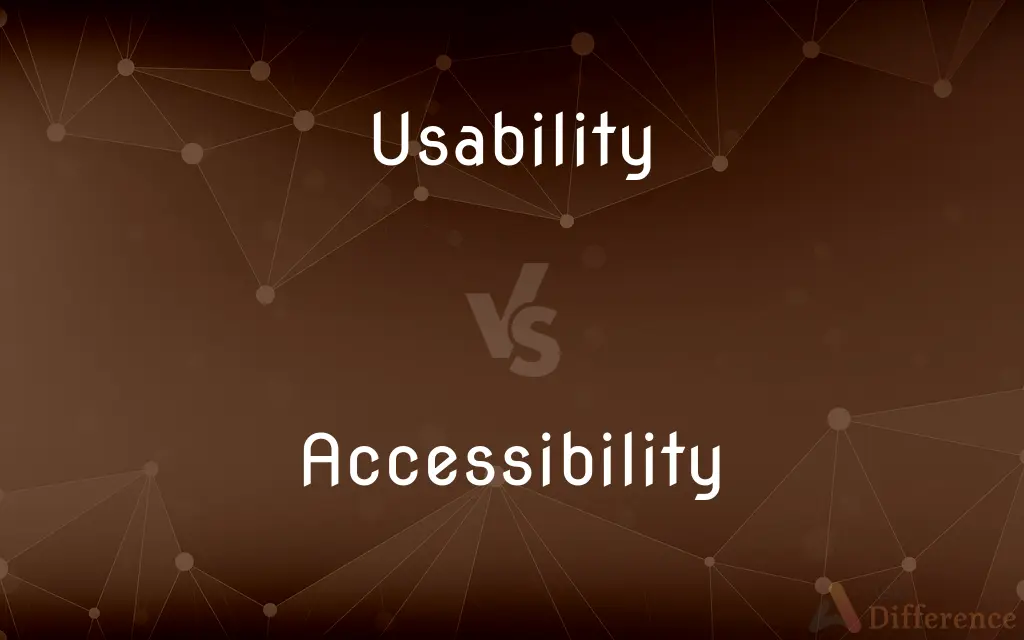Usability vs. Accessibility — What's the Difference?
By Tayyaba Rehman & Maham Liaqat — Updated on April 18, 2024
Usability focuses on how easily users can interact with a system, aiming for efficiency and satisfaction; accessibility ensures systems are usable by people with various disabilities.

Difference Between Usability and Accessibility
Table of Contents
ADVERTISEMENT
Key Differences
Usability is primarily concerned with how user-friendly and efficient an interface is for its users, focusing on ease of use and learnability. Whereas accessibility is about ensuring that products and services are usable by everyone, including those with disabilities, encompassing a wide range of impairments such as visual, auditory, physical, and cognitive.
In terms of design, usability often deals with general user experience aspects such as layout, user guidance, and interactive elements that make software intuitive and easy to use. On the other hand, accessibility involves specific adaptations or features that help overcome barriers, such as screen readers for the blind, captioning for the deaf, and adaptive hardware for physical disabilities.
Usability testing typically involves observing typical users as they interact with the system to identify areas for improvement to enhance user satisfaction and performance. Whereas accessibility testing might include assessments by users with disabilities or use of specialized tools to ensure compliance with standards like the Web Content Accessibility Guidelines (WCAG).
Usability enhancements are often aimed at making systems more straightforward and efficient for as many users as possible without necessarily focusing on disability. In contrast, accessibility focuses on eliminating barriers that might prevent people with disabilities from using the system entirely.
While usability is a broad discipline that can apply to any user interface, accessibility is a specialized field that aligns with legal and ethical obligations, aiming to provide equal access and opportunities to people with disabilities.
ADVERTISEMENT
Comparison Chart
Focus
Efficiency and satisfaction of all users
Usability for people with disabilities
Design Considerations
Intuitive layout, clear navigation
Screen readers, captions, adaptive hardware
Testing
Typical user interactions
Compliance with standards, user disabilities
Enhancements
General improvements for ease of use
Specific features for overcoming disabilities
Regulatory Alignment
Best practices and guidelines
Legal requirements like ADA, WCAG compliance
Compare with Definitions
Usability
The process of making products easier for people to use.
Usability improvements in the app have significantly reduced customer complaints.
Accessibility
The ability of a system to be used by everyone, especially providing access to people with disabilities.
Accessibility features in the software include voice recognition and text-to-speech.
Usability
Quality attribute that assesses how easy user interfaces are to use.
The new website design focuses more on usability, making navigation seamless.
Accessibility
A characteristic of technology that enables use by people with a wide range of abilities.
Making video content accessible involves adding subtitles and audio descriptions.
Usability
The effectiveness, efficiency, and satisfaction with which specified users achieve specified goals.
Usability testing revealed that users found the checkout process confusing.
Accessibility
The design of products, devices, services, or environments for people with disabilities.
The building's accessibility was improved by adding ramps and elevators.
Usability
The extent to which a product can be used by specified users to achieve specified goals.
To assess the system’s usability, we conducted user tests.
Accessibility
The degree to which a product or environment is available to as many people as possible.
To increase accessibility, the company introduced software compatible with assistive technologies.
Usability
The ease of use and learnability of a human-made object such as a tool or device.
The software's usability was enhanced by its simplified interface.
Accessibility
Ensuring that systems are usable across different types of disabilities.
The recent updates to our application have significantly enhanced its accessibility for visually impaired users.
Usability
Usability can be described as the capacity of a system to provide a condition for its users to perform the tasks safely, effectively, and efficiently while enjoying the experience. In software engineering, usability is the degree to which a software can be used by specified consumers to achieve quantified objectives with effectiveness, efficiency, and satisfaction in a quantified context of use.The object of use can be a software application, website, book, tool, machine, process, vehicle, or anything a human interacts with.
Accessibility
Accessibility in the sense considered here refers to the design of products, devices, services, or environments so as to be usable by people with disabilities. The concept of accessible design and practice of accessible development ensures both "direct access" (i.e.
Usability
Capable of being used
Usable byproducts.
Accessibility
The quality of being able to be reached or entered
The restoration project involved repairing the roof and improving accessibility
Usability
Fit for use; convenient to use
Usable spare parts.
Accessibility
Easily approached or entered
The stadium is accessible via public transportation.
Usability
The state or condition of being usable.
Accessibility
Easily obtained
Accessible money.
Usability
The degree to which an object, device, software application, etc. is easy to use with no specific training.
Accessibility
Easy to talk to or get along with
An accessible manager.
Accessibility
Easy to understand or appreciate
An accessible artwork.
Accessibility
Designed for use by anyone regardless of physical ability
Remodeled the restroom to make it accessible.
Accessibility
Easily swayed or influenced
Accessible to flattery.
Accessibility
The quality of being accessible, or of admitting approach; receptiveness.
Accessibility
Features that increase software usability for users with certain impairments.
Accessibility
The quality of being accessible, or of admitting approach; receptibility.
Accessibility
The quality of being at hand when needed
Accessibility
The attribute of being easy to meet or deal with
Common Curiosities
Can a product be usable but not accessible?
Yes, a product can be easy to use for non-disabled users but difficult or impossible for users with certain disabilities.
What is usability?
Usability refers to the ease with which any user can utilize a product or system to achieve their goals.
What is accessibility?
Accessibility means ensuring that products and services are functional and usable for people with disabilities.
What specific design elements enhance accessibility?
Features like high contrast colors, text to speech, and navigable interfaces using a keyboard.
How do usability and accessibility testing differ?
Usability testing can involve typical user scenarios, while accessibility testing specifically includes scenarios for users with disabilities.
How do usability and accessibility intersect?
Both aim to improve user experience, but accessibility focuses specifically on inclusion for users with disabilities.
What are common tools for testing usability?
Usability testing often uses surveys, user observations, and task analysis.
How does design think about usability?
Design for usability focuses on making products intuitive, efficient, and satisfying for users.
Why is accessibility important?
Accessibility ensures that everyone, regardless of disability, has equal access to information and technology.
What standards guide accessibility?
The Web Content Accessibility Guidelines (WCAG) and the Americans with Disabilities Act (ADA) are key standards.
What is an example of a usability improvement?
Simplifying a website’s menu structure to reduce the number of clicks to find information.
Is accessibility legally required?
In many jurisdictions, accessibility is required by laws such as the ADA for public and commercial entities.
What is an example of an accessibility feature?
Providing text descriptions for images on websites to aid users who are visually impaired.
How can developers ensure their products are both usable and accessible?
By integrating usability and accessibility considerations into the design process from the start and conducting thorough testing with diverse users.
Can enhancing usability improve accessibility?
Improvements in usability can sometimes enhance accessibility, but specific measures are often needed for full accessibility.
Share Your Discovery

Previous Comparison
Dangleberry vs. Huckleberry
Next Comparison
Beseech vs. BegAuthor Spotlight
Written by
Tayyaba RehmanTayyaba Rehman is a distinguished writer, currently serving as a primary contributor to askdifference.com. As a researcher in semantics and etymology, Tayyaba's passion for the complexity of languages and their distinctions has found a perfect home on the platform. Tayyaba delves into the intricacies of language, distinguishing between commonly confused words and phrases, thereby providing clarity for readers worldwide.
Co-written by
Maham Liaqat















































